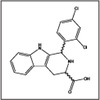 A chemical rescue screen identifies a P.falcip. apicoplast inhibitor targeting MEP isoprenoid precursor biosynthesis
A chemical rescue screen identifies a P.falcip. apicoplast inhibitor targeting MEP isoprenoid precursor biosynthesisWesley Wu, Zachary Herrera, Danny Ebert, Katie Baska, Seok H. Cho, Joseph L. DeRisi, Ellen Yeh
AAC, 2014Abstract: The apicoplast is an essential plastid organelle found in Plasmodium spp parasites, which
contains several clinically validated anti-malarial drug targets. A chemical rescue screen
identified MMV-08138 from the “Malaria Box” library of growth-inhibitory anti-malarial
compounds as having specific activity against the apicoplast. MMV-08138 inhibition of blood
stage P. falciparum growth is stereospecific and potent, with the most active diastereomer
demonstrating an EC50=110 nM. Whole-genome sequencing of 3 drug-resistant parasite
populations from two independent selections revealed E688Q and L244I mutations in P.
falciparum IspD, an enzyme in the MEP isoprenoid precursor biosynthesis pathway in the
apicoplast. The active diastereomer of MMV-08138 directly inhibited PfIspD activity in vitro
with an IC50 of 7.0 nM. MMV-08138 is the first PfIspD inhibitor to be identified and, together
with heterologously expressed PfIspD, provides the foundation for further development of this
promising anti-malarial drug candidate lead. Furthermore, this study validates the use of the
apicoplast chemical rescue screen coupled with target elucidation as a discovery tool to identify
specific apicoplast-targeting compounds with new mechanisms of action.
